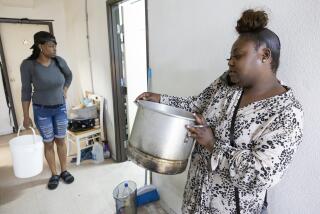Mass Evictions Leave Residents Down--and Out
- Share via
SACRAMENTO — The eviction notices hit out of the blue. Whole subdivisions full of renters--570 single-family houses in the capital’s suburbs and to the west in Santa Rosa--were given 30 days to pack up furnishings, pull kids from school, uproot settled lives.
What followed was hardly the typical eviction process in California.
Instead of grimacing and taking it, the outraged residents fought back en masse against Genshiro Kawamoto, a wealthy Japanese investor who was putting their rental homes on the sales block. Ultimately, Kawamoto buckled, giving tenants extra time. But the damage, in many cases, had already been done.
Scores of tenants have already moved, crowding into a fist-tight rental market, paying more for lesser homes. A few hope that Kawamoto will sell them the houses they have occupied, in some cases, for a decade. Others say they are too embittered and will move.
There is talk in some circles of making a concerted push around the state for rent control and “just-cause” eviction laws. State lawmakers may make a run at doubling the 30-day notice required for eviction, allowing tenants more time to relocate.
Landlords don’t like the sound of any of it.
They say eviction restrictions may give renters more time to look, but do nothing to increase the supply of available rentals--which they say is the real problem. Moreover, delays and restrictions make it difficult to evict tenants who are bad apples. For landlords, eviction limits can act to poison business opportunities, further eroding the push to build more housing.
Jim Lofgren, executive director of the Rental Housing Assn. of Sacramento Valley, said landlords are upset with Kawamoto, whose effort at mass eviction--though “an aberration”--could cause legislative changes that Lofgren believes will hurt more than help.
“His single act has generated such outrage that it may cause unnecessary changes to the law that will seriously affect the industry,” he said.
“What he did happens about as often as the appearance of Halley’s comet, and I hope legislators realize that.”
What befell Kawamoto’s tenants, however, isn’t all that unusual, renter advocates say. The hot real estate market in California and other regions of the country, they say, is causing landlords to regularly push tenants into the streets so they can raise rents or sell for substantial profit.
“This is the worst affordability crisis we’ve ever seen,” said Christine Minnehan, housing advocate for the Western Center on Law and Poverty. “What happened in Sacramento and Santa Rosa was front-page news, but the poor of this state put up with it daily.”
Kawamoto’s tenants got so much attention partly because of the audacious scale of the evictions.
“If he had done this 50 at a time,” said Rod Fields of the Los Angeles Housing Law Project, “nobody would have known about it except the local legal aid office.”
The socioeconomics of the subdivisions also came into the equation. Solidly middle class, they are filled with young professionals and families who proved savvy in the twin realms of media and politics.
Calls were made in equal numbers to local TV outlets and lawmakers. Signs were posted on street corners. One resident of a subdivision in the Sacramento area city of Citrus Heights, a carpenter named Eric Goesch, jetted off to Washington to make the rounds with lawmakers. Politicians from Gov. Gray Davis to U.S. Sen. Dianne Feinstein complained to the Japanese Embassy. Legal services firms went to court for the tenants, winning a preliminary round.
It paid off, convincing Kawamoto to give tenants the 90-day grace period they sought and drawing help from the private sector.
The local apartment association passed out a booklet of available rentals. Mortgage brokers offered free services for any who sought to buy a home. Sacramento-based Nehemiah Corp. of California, a nonprofit organization, offered to buy one whole subdivision to rent back to tenants, then give them the opportunity to buy.
Such housing is hard to come by all over the state. In Los Angeles, the vacancy rate hovers around 3%. In some parts of the Bay Area, it’s less than 1%. Sacramento is better, with some Realtors saying the rate may be rising toward 4% or 5%, but what is available is mostly apartments, not houses.
Rhonda Warner is finding the pickings thin.
Residents of Villa Creekside, a Citrus Heights neighborhood owned by the Japanese investor, Warner’s family isn’t bothering to stick around. She has been looking hard, but is finding only houses that rent for double what she now pays and landlords that balk over her family pets.
“We’re waiting tonight to see if we get a house,” she said one evening out on her lawn. “The trouble is, everyone else is fighting for it too.”
Goesch, another Villa Creekside resident, knows one couple who sold their dog to move into a new place that didn’t take pets. Another neighbor was forced out in the middle of cancer chemotherapy. Still another just had heart surgery.
By Goesch’s reckoning, upward of 2,500 people are affected in the half a dozen subdivisions owned by Kawamoto.
“We’ve got bleeding heart stories all over,” he said. “But they’re all true.”
In the Stony Point-Villa Royale neighborhoods of southwest Santa Rosa, many residents have already cleared out.
The post office has received 40 change-of-address forms. The local U-Haul office said it’s having trouble keeping trucks in stock. So many people moving at once has strained the local housing market.
Those left behind feel like they’re living on an empty movie set--the props are in place, but people are lacking.
Kathy Wagner, 55, said she’s thinking of locking her garage door for the first time since she moved in. “It’s kind of scary,” she said.
Most people who do find housing are discovering that they must pay more for less. “Here we pay $1,190 rent. Our new place is smaller but we’re paying $300 more,” said Christine Chisholm, 25, who is living with her parents.
Though there is talk that arrangements might be made for residents to rent longer or even buy, many are so upset by the turmoil that they have no interest in staying.
“Are we angry? Yes,” said Wagner. “Do we want to see karma happen? Yes.”
Some have fallen ill. “The eviction flu,” Wagner calls it.
And though she and others displaced by Kawamoto don’t dispute his right to sell, they resent the way it was done.
“To come into a community like this and turn our lives upside down,” Wagner said, “it’s like a disaster.”
*
Bailey reported from Sacramento and Johnson from Santa Rosa.
More to Read
Inside the business of entertainment
The Wide Shot brings you news, analysis and insights on everything from streaming wars to production — and what it all means for the future.
You may occasionally receive promotional content from the Los Angeles Times.








